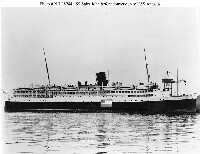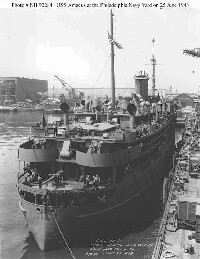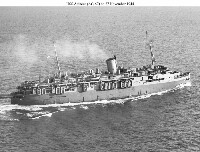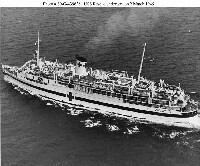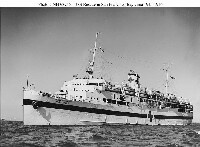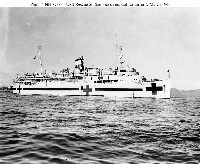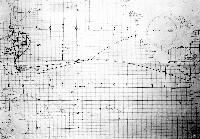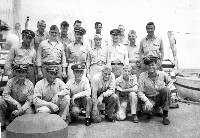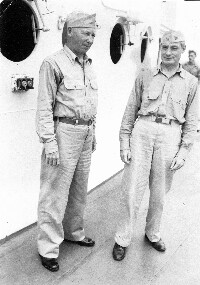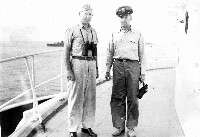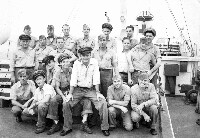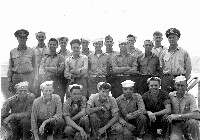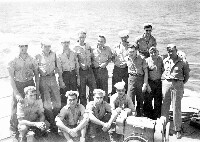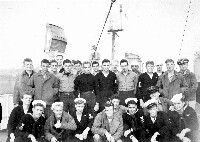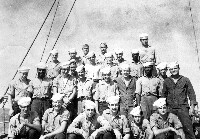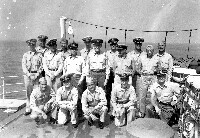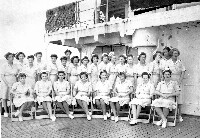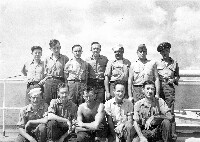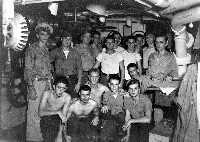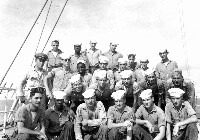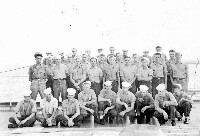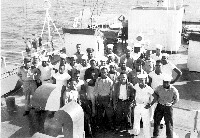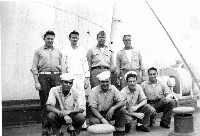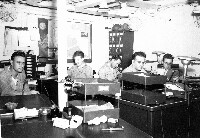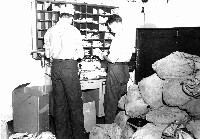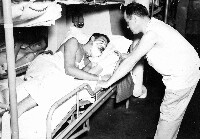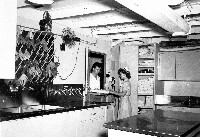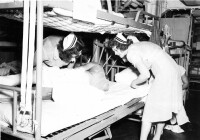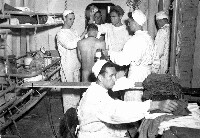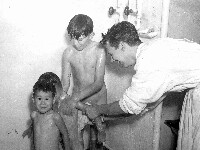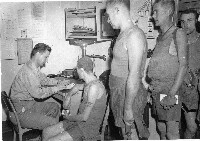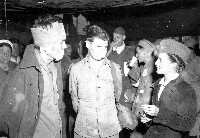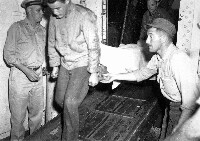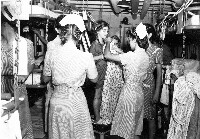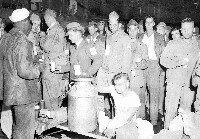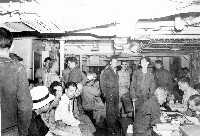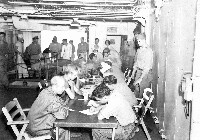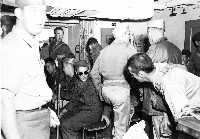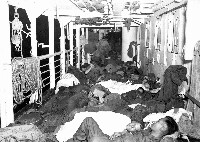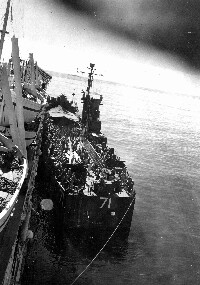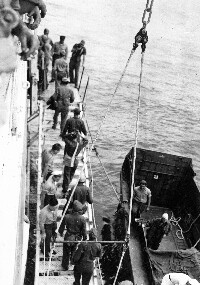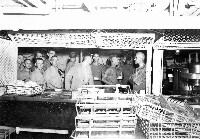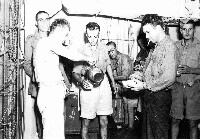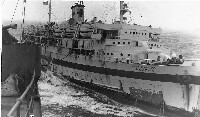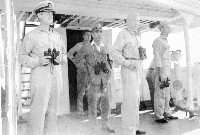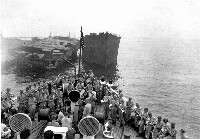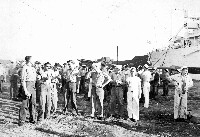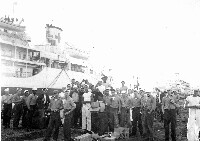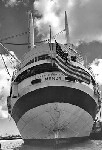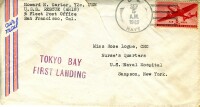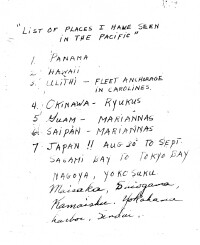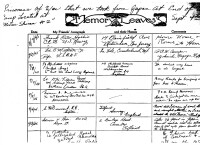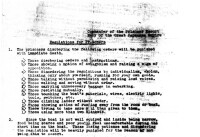List of Places I
Have Seen in the
Pacific
(USNHS Rescue War
Diary)
by
HA2 John Douglas
“Doug” Neighbors USNR
High Point, NC
1. Panama (Canal)
2. Hawaii
3. Ulithi Fleet Anchorage - Caroline Islands
4. Okinawa - Ryukus Islands
5. Guam - Marianas Islands
6. Saipan - Marianas Islands
7.
Japan!! August 30 to September 1945: Sagami Bay to Tokyo Bay, Nagoya,
Yokosuka, Maiasaka, Shiogama, Kamaishu, Yokohama harbor, Sendai.
Coast
of Japan
July 16, 1945
Today is July 16th.
We,
the members of the USS Rescue, are lying off the Coast of Japan. Our
position runs latitudinal with Honshu. We are members of Admiral
Halsey’s 3rd Fleet. Our ship is the (AH-18) Auxiliary Hospital Ship
“RESCUE”. This ship was formerly the (troop) transport “ANTAEUS”. She
was converted in February of 1945. We left Brooklyn (Navy Yard) on
March 3rd, 1945.
From there, we went to Norfolk, VA. We loaded some
supplies there and left on a nine (9)-day trip to Panama. We spent two
days in Panama, where I took one liberty in Balboa, one of the
Panamanian cities. Liberty was the best and more like liberty in the
States there than any place I have seen yet, including Hawaii.
From
there, we went to Hawaii (Pearl Harbor). We spent about 6 weeks there,
installing hoists, etc. for hoisting patients onto the ship. Also, a
lot of supplies were loaded onto the ship there. The ship was also
painted again there. I spent many liberties in Honolulu and Waikiki
Beach there. I started an album of pictures, etc.
After leaving Pearl
Harbor, we set out for Ulithi (Atoll), a Fleet Anchorage about 3-4 days
from Okinawa. I saw almost as many ships there as I saw in Brooklyn.
There was //one line
missed in copier// as far as you could see around
you. In our trip from Hawaii, we bypassed a couple little islands; one
of them was Wake, still held by the Japs. Recently, a Japanese Hospital
Ship (“Awa Maru”) took over one thousand (1000) patients from Wake. She
was given free passage by America, since she was a Ship of Mercy and
was of no military importance. All of the patients on the Jap hospital
ship from Wake were suffering from malnutrition. This island which is
left stranded without medical aid or food supplies will, no doubt,
starve to death. She is still held by the Japs, but, no doubt, will
finally give up. She is of no military value to us and was not worth
wasting the lives of our men to take back. We are much farther advanced
toward Japan, anyhow. The Jap doctors on the Japanese hospital ship
estimated that 15% of their 1000 or more patients would die before they
could get back to the Jap mainland with them. The Jap hospital ship was
investigated by men from one of our destroyers.
But, getting back to
Ulithi, the Fleet Anchorage, we took patients from several of the ships
(anchored) there before leaving for Okinawa. When we arrived at Okinawa
in the middle of June, the Marines and Army were having trouble there.
They had no opposition there at first when they landed, but on the
southern end of the island, they were still fighting heavily, and were
still fighting for a few days after we left there with a load of
patients.
When we arrived at Okinawa, we saw several battlewagons,
cruisers, destroyers, etc. lying off shore firing salvos into the Jap
positions. When we arrived at our anchoring place, about a mile from
shore and a couple miles from the fighting, we saw the USN Hospital
Ship “Solace” (AH-5), which was already loaded, and did pull out the
next day. We were loading patients there 4 or 5 days and worked like
hell. When we worked like hell all day long for 14 hours, we sure did
fell like hitting the “old sack” at night, but there was no rest for
the weary, because every time we got to sleep, the Japs gave us a raid
with suicide planes, of course, or bombs. And we would have to go to
our attack quarters. Of course, this wasn’t too good on our patients,
either, because they were wounded & sick men. They were very
good
patients, though.
One night, the Japs nearly hit us off the starboard
bow with bombs. They found shrapnel all over the deck the next morning,
and I think that three men on a ship next to us were wounded by
shrapnel from those bombs. I can’t say I wasn’t scared that night
because I sure as hell was. The Japs sank the destroyer “USS Twiggs”
(DD-591) and we got several patients from her. She was hit by a suicide
plane.
We got one patient with a compound fracture of the mandible
(lower jaw) and other cuts and lacerations, from the “USS Twiggs”. His
name was Billy Sulcer, and he was from Alabama. He was a good kid, and
I was given a special watch on him, more or less. Of course, all these
kids out here are good kids, and they’re all doing their job, a better
job than I am doing because I’m in the Medical Corps. But we do our
job, too, and I think we have done a swell job so far.
One morning
while Sulcer was in the shower, he complained that his head hurt, and I
looked at his head, which had quite a large laceration. I cut his hair
and shaved his head around the wound, and then applied treatment and
bandage. He took a liking to me, and said that he would send me a quart
of whiskey when he gets back to the States. I’m still looking for it!
By the way, I certainly would like to have a drink right now.
We went
through bombings every night at Okinawa, sometimes three or four raids
a night. When we finally were filled with patients, we went on a
four-day trip to Guam, one of the Mariana Islands. We unloaded all our
patients there, and incidentally there was one thing more that I forgot
to mention (about Okinawa). I met a buddy from my home town, who was
with the 8th Marine Regiment on Okinawa. He was not a victim of the
Japanese, but one of his own buddies accidentally fell on his toe with
a knife and severed it right below the nail of the toe. Not serious,
but enough to get him out of action with part of his toe gone, since he
couldn’t carry on as usual. He was also from High Point, NC. His name
was Jack Smith. We had a big laugh out of it, and was ashamed of his
wound, but nevertheless it might have been a good thing, since he had
been out here (Pacific Theater) for 30 months, and had seen all the
campaigns out here: Tarawa, Saipan, Tinian, etc. I imagine that he was
sent back to the States from Guam.
From Guam, we went to Saipan, where
I went ashore looking around for souvenirs, and drank my usual three
cans of beer. After a couple days, we went back to Guam for a few days
and on July 5th, we left Guam for a rendezvous with the 3rd Fleet.
The
3rd Fleet is now bombing and shelling holy hell out of Tokyo and every
other Japanese city. We (USNHS Rescue) are lying here, or rather, we
are moving around in a circle, waiting for this naval force (3rd Fleet)
to return and to take their patients, if they have any, from this
daring attack by the 3rd Fleet of Admiral Halsey on the Jap mainland.
They aren’t getting much opposition from the Japs at present.
There is
one other incident I wish to tell you about and that is concerning the
suicide plane attack on the (USNHS) Comfort (AH-6) in May (1945).
Perhaps there is a reason for this inhumanly act. If you recall back in
April, the “Awa Maru”, a Japanese relief ship, exchanging prisoners
with us was granted free movement in our waters. She was sunk with a
loss of over 1000 lives to the Japanese, by one of (our) submarines,
due to the fact that she could not be recognized because of a fog. This
information concerning the “Awa Maru” was just recently revealed to us.
So since the Japanese relief ship was sunk by us, the Japs attacked our
hospital ship. I know we are constantly observed by the Japs, but so
far, so good, they haven’t given us any trouble as yet. But they are
being pretty well occupied by the Fleet in and around Tokyo Bay and
Hokkaido.
"August 15th"
Japan accepts the Potsdam Ultimatum
and the “Rising Sun” has set on a land that has caused not only
America, death and destruction, but also to themselves. With the Atomic
Bomb, the Russian entry into the war, and the bombardment by the 3rd
Fleet of the Jap homeland, no doubt ended the war a lot sooner than we
all thought. Peace was signed officially on September 2nd. Thank God!
The world is once more at peace and we can return home and be civilians
once more.
Commander of
the Prisoner Escort
Navy of the Great
Japanese Empire
Regulations
for Prisoners
1. The prisoners disobeying the following orders will be punished with
immediate death.
a) Those disobeying
orders and instructions.
b) Those showing a motion of antagonism and raising a sign of
opposition.
c) Those disobeying the regulations by individualism, egoism, thinking
only about yourself, rushing for your own goods.
d) Those talking without permission and raising loud voices.
e) Those walking and moving without order.
f) Those carrying unnecessary baggage in embarking.
g) Those resisting mutually.
h) Those touching the boat’s materials, wires, electric lights, tools,
switches, etc.
i) Those climbing ladder without order.
j) Those showing action of running away from the room or boat.
k) Those trying to take more meal than given to them.
l) Those using more than two blankets.
2.
Since the boat is not well equiped and inside being narrow,
food
being scarce and poor you’ll feel uncomfortable during the short time
on the boat. Those losing patience and disordering the regulation will
be heavily punished for the reason of not being able to escort.
3. Be sure to finish your “nature’s call”, evacuate the bowels and
urine, before embarking.
4.
Meal will be given twice a day. One plate only to one prisoner. The
prisoners called by the guard will give out the meal quick as possible
and honestly. The remaining prisoners will stay in their places quietly
and wait for your plate. Those moving from their places reaching for
your plate without order will be heavily punished. Same orders will be
applied in handling plates after meal.
5. Toilet will be fixed
at the four corners of the room. The buckets and cans will be placed.
When filled up a guard will appoint a prisoner. The prisoner called
will take the buckets to the center of the room. The buckets will be
pulled up by the derrick and thrown away. Toilet papers will be given.
Everyone must cooperate to make the room sanitary. Those being careless
will be punished.
6. Navy of the Great Japanese Empire will not
try to punish you all with death. Those obeying all the rules and
regulations, and believing the action and purpose of the Japanese Navy,
cooperating with Japan in constructing the “New Order of the Great
Asia” which lead to the world’s peace will be well treated.
The End.
Evacuation
of POWs from Maisaka and Sendai - courtesy of Joseph Carter
I have only downloaded USNHS
RESCUE files to the point of their departure from GUAM on 24 Sept
1945. It didn’t look like they transported many POWs directly
from Maisaka (4-7 Sept) and Sendai (11-15 Sept), and those they
transferred to the BENEVOLANCE upon arrival in Yokohama, but when they
prep’d on Sept 16-19 to depart for CONUS via Guam and Hawaii, they
really loaded up with “patients” from the USAHS MARIGOLD & USNHS
BENEVOLENCE and area hospitals. They evac’d only 27 e.m. plus 1
officer from Maisaka, and 17 e.m. plus 2 officers from Sendai, but the
RESCUE departed Japan on Sept 19th, they were loaded with 360 e.m. and
30 officer patients bound for either Guam, Hawaii, or CONUS. In
Guam, they were receiving and transferring patients, and I stopped
there temporarily. I haven’t gotten to the arrival in Hawaii, and
the final arrival in San Francisco. I did look ahead to the
“end of the book” and noted that as of 1 Jan 1946, the designator of
the USNHS Rescue (AH-18) changed to USS Rescue (APH-118). The
ship made two more trips to Hawaii (1 in 1945, and 1 in 1946) under the
“Magic Carpet” operation before being put into “mothballs” at Bremerton
WA.
It looked like the BENEVOLENCE was permanently stationed in Yokohama to
receive and treat patients from ambulance hospital ships like
RESCUE. The repatriation operation must have been
huge. I know from the photographs that the RESCUE treated
POW children but they were not noted in the official “muster rolls” as
being transported to Yokohama. They may have been simply treated
on RESCUE and transported on another, faster ship or by aircraft.
Sendai POW evacuee reports from the RESCUE muster rolls: All were
transported to Yokohama and turned over to the BENEVOLENCE on 15 Sept
1945. From 16 to 19 Sept, RESCUE took on 360 enlisted and 30 officer
patients for transport back to CONUS (via Guam and Hawaii). RESCUE
departed Japan on 19 September and spent 20-24 Sept at Guam receiving
and transferring patients before moving on to Hawaii.
|
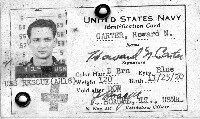 "My
father was the yeoman to Captain Robert Twining (ret-active), who
commanded the Rescue
from January 1945 to surrender (when he was
relieved of duty and shipped back to CONUS for re-retirement). Captain
Twining was the eldest of three military brothers: Robert
Twining, Captain USN; Nathan F. Twining, General USAAC/USAF; and
Merrill
G. Twining, LtGen USMC.
"My
father was the yeoman to Captain Robert Twining (ret-active), who
commanded the Rescue
from January 1945 to surrender (when he was
relieved of duty and shipped back to CONUS for re-retirement). Captain
Twining was the eldest of three military brothers: Robert
Twining, Captain USN; Nathan F. Twining, General USAAC/USAF; and
Merrill
G. Twining, LtGen USMC. "My
father was the yeoman to Captain Robert Twining (ret-active), who
commanded the Rescue
from January 1945 to surrender (when he was
relieved of duty and shipped back to CONUS for re-retirement). Captain
Twining was the eldest of three military brothers: Robert
Twining, Captain USN; Nathan F. Twining, General USAAC/USAF; and
Merrill
G. Twining, LtGen USMC.
"My
father was the yeoman to Captain Robert Twining (ret-active), who
commanded the Rescue
from January 1945 to surrender (when he was
relieved of duty and shipped back to CONUS for re-retirement). Captain
Twining was the eldest of three military brothers: Robert
Twining, Captain USN; Nathan F. Twining, General USAAC/USAF; and
Merrill
G. Twining, LtGen USMC.